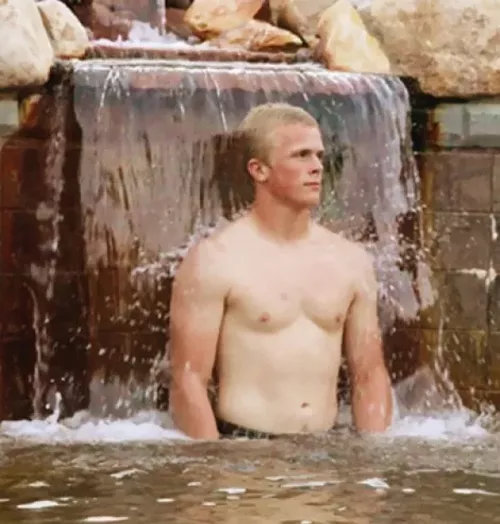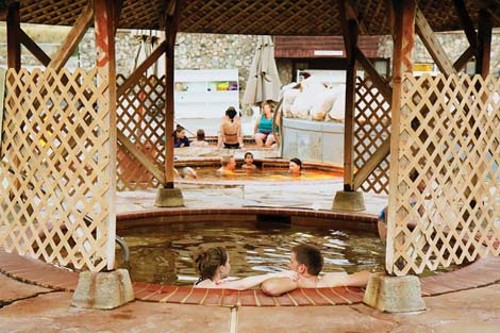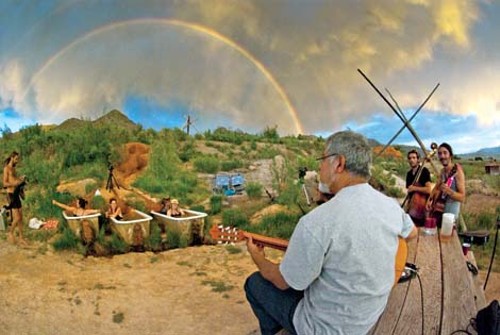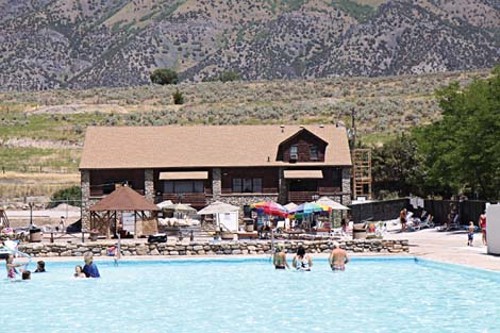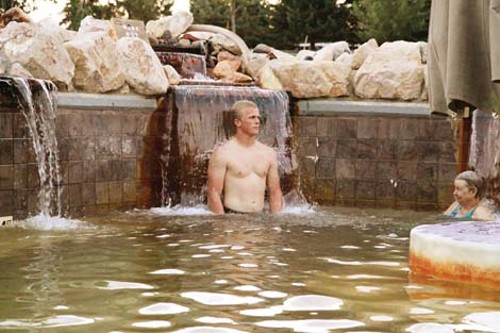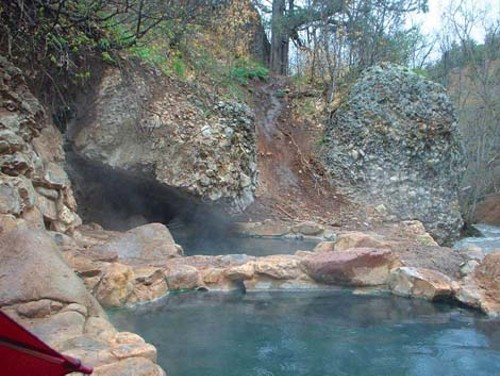All Warm, Some Naked: Utah's Hot Springs
Into Hot Water: Utah's love/hate relationship with its natural hot springs.
By Jim CatanoYou’d pay good money for this, but admission was free. Well, almost. You drove an hour and a half from Salt Lake City through Spanish Fork Canyon, then trekked 2 1/2 miles (or seven, if snow closed the road) up a sometimes-steep trail with drop-offs that could fatally injure a careless hiker.
Once at Diamond Fork Hot Springs (also known as Fifth Water), all thoughts of long drives and challenging hikes fade as you slip into one of several ponds heated by powerful geological forces. You’re in full and direct contact with the ancient four elements: earth, water, air and fire. Even though the sun is down, the fire still burns. You feel it in the warmth that envelops you. You may be completely alone, but you’re “connected.” This is heaven—or as close as some imagine it.
| |
Want to "Hot Spring"? A history of Utah's former hot spring resorts (Note: Pah Tempe has now re-opened) Soaking etiquette: Utah commercial hot spring resort sites: Sites for serious soakers:
|
That’s what a midwinter, middle-of-the-week visit to Diamond Fork can be like. At other times, especially on a summer weekend, you may find yourself at the same place surrounded by a loud party of high school or college kids (including a few BYU rebels).
Diamond Fork may be Utah’s most beautiful “wild” hot spring, but it’s not the only one. Each offers a different personality to the serious “soaker.” And three developed, commercial hot spring resorts (Crystal, Mystic and Pah Tempe) currently operate in the state. Two others, Homestead Resort and Veyo Pool, feature “warm springs” at below body temperature (98.6 degrees).
That wild hot springs can even exist close to Utah’s metropolitan areas is surprising. Long magnets for naturists (those who bathe in the nude), party animals getting drunk or stoned, homeless folk seeking a warm bath and, at some, hordes of mosquitoes, Utah’s hot springs aren’t always family-friendly recreational spots. In response, government officials have been known to blow them up (as with Castilla Hot Springs in Utah County) or box them in (as with Salt Lake City’s Warm Springs Park). To find a truly world-class hot-springs “destination” resort spa requires a trip out of state, even though water boils just under our feet at several spots along the Wasatch Front. So, in an arid state where every drop of water is precious, why is Utah so averse to utilizing its hot water?
Utah wasn’t always hot-springs resistant. Mormon pioneers took a cue from American Indians, who considered thermal springs a peaceful place to heal, even if warring tribes happened to be present. Warm Sulfur Springs came into being on what is now about 850 N. Beck St. According to Louise Pearce’s “Salt Lake City’s Vanishing Hot Springs,” an article written in 1969 for a state historical dedication ceremony, Mormon pioneer Thomas Bullock in 1847 called the springs a “blessing” for “poor Saints who are weak, sickly, and affected … and almost every complaint will here be healed.” By 1850, a resort there featured Utah’s first public dance and recreation hall. Mule-drawn trolleys delivered patrons. The resort thrived, then gradually declined and closed in 1951. The building that most recently housed the Children’s Museum still stands. Much of the water has been diverted, but Warm Springs Park remains. A warm pool had been made too shallow for soaking, but transients now use it for sponge bathing.
In 1885, German miner John Beck built Beck’s Hot Springs Resort three miles farther north, where an interstate highway, train tracks, refineries, and other industries now dominate the terrain. A railway once carried eager soakers to the spot from downtown.
Five other Utah hot-spring resorts rose and fell on the heels of shifting social dynamics. As indoor plumbing became common, the attraction of public bathing declined. In the late 1800s, physicians convinced the public to rely more on medical cures. A 1950s polio scare brought requirements for prohibitively expensive chlorination of constantly flowing waters. TV and radio replaced the live music that had been a big part of the appeal. And a series of devastating fires took their toll. Finally, the state of Utah condemned what had been Beck’s resort in 1953 to build a new highway (now Interstate 15) and, “so ends of the story of Beck’s Hot Springs,” Pearce wrote.
In the “All Together”
Before the age of hot tubs, an underground breed of wild hot-spring soakers began sharing secrets of obscure, little-known springs by word of mouth and through magazines and books.
Historically—and even today throughout much of the world—soaking is done “au naturel,” even by sober folks, with both genders present, in a decidedly nonsexual way. Tolerance for nudity varies community by community, and, not surprisingly, Utah falls far on the conservative side. But regulations against public nudity were enforced only occasionally at most wild hot springs until recently—even in tightly wound Utah County. Nude soaking was a common practice, even in daylight, at Diamond Fork; if officers showed up, they often just asked naturists to put on a bathing suit.
But the 2009 arrest of eight Forest Service firefighters changed that dynamic [see “Skinny Dipper Crackdown,” Dec. 16, 2009]. While celebrating the end of fire season, soakers were approached in the dark by sheriff’s deputies shining flashlights on them and given misdemeanor citations for lewdness. Never mind that they were submerged up to their necks water that was opaque in the night.
But there was a glitch: A 3-year-old U.S. Forest Service trailhead sign noted, “Nudity is not prohibited.” The firefighters, like so many others, had assumed they were safe soaking in the nude if they used discretion around families and Scout troops, as the sign requested.
Spanish Fork National Forest District Ranger Doug Jones had erected the sign at the encouragement of several soakers. It was later determined that, in this instance, local laws pertaining to public nudity trump the federal policy tolerating nudity on federal lands. The case received national attention, and naturist organizations volunteered to aid the defendants. In light of the contradiction, the Utah County Attorney later dropped all charges [see Hits & Misses: “Naked Justice,” July 22, 2010].
The new level of enforcement isn’t sitting well with those who’ve enjoyed “non-textiled” use of Diamond Fork for decades. Some now restrict soaking to two harder-to-get-to pools above the main pools. A few keep bathing suits close by to slip on at the approach of law enforcement-looking types. Others hope for a warning. But a few intend to challenge the legitimacy of Utah’s lewdness code.
Janae Bird (the subject of City Weekly’s June 2, 2010, cover story “Jailed for Sexual Healing”) has been holding spiritual and meditative religious services in the nude at Diamond Fork for years. She and members of her Church of What Is Real continue to perform those rites in possession of ID cards issued by the Okleveuha Native American Church and assert that they’re protected in worshiping sans clothing. They may be onto something.
Tim Taylor, a prosecutor with the Utah County Attorney’s Office, admits there may be merit to these naturists’ argument. He said that nudity in religious services may be “somewhat analogous” to a case the government lost to James “Flaming Eagle” Mooney over the use of peyote in Native American ceremonies. Taylor says the county will show “extreme caution” and “remain circumspect in not violating religious freedoms.” Coincidentally, the nudity-advocating Okleveuha Church is headed by Mooney.
Other naturists who’ve requested anonymity plan to, if cited in the future, mount a selective prosecution challenge to Utah code 76-9-702, which reads: “A person is guilty of lewdness if ... the person ... exposes his or her genitals, the female breast below the top of the areola, the buttocks, the anus, or the pubic area.” They’re prepared to argue that the exposure of women’s breasts is not inherently indecent because the same law provides a blanket exemption for nursing mothers. They contend that many swimsuits expose ample portions of the breasts and derriere, but police aren’t showing up at public pools to cite bikini wearers.
Prosecutor Taylor says the Utah County officials “don’t want to be the fashion police.”
But according to the Utah County Sheriff Chief Deputy over enforcement Jerry Monson, “Nudity isn’t the main problem at Diamond Fork, nor is it the reason for occasional patrols there.” Of more concern are “underage drinking, illegal drug use and break-ins into parked vehicles, especially overnight.” But he says it remains within an officer’s discretion to cite nude bathers even if they’re forced to get up out of a cloudy pool in the dark to be seen naked by flashlight.
Bird and other naturists hope a compromise at Diamond Fork can be reached, such as “an exemption for nude use of the more secluded upper pools.” Others suggest night-only nudity if all present consent, especially if clothed individuals show up after nude soakers are already there.
Paying to Play
For those looking for a tamer experience, a developed resort may be the ticket. At first glance, Crystal Hot Springs (an hour’s drive north of Salt Lake City) looks like an older municipal pool complex, complete with water slides and kids everywhere.
But then there’s the water. High mineral content is considered ideal for balneotherapy—the practice of treating diseases through soaking in hot baths—and is highly regarded in Europe and Asia, where mainstream physicians often prescribe trips to hot springs. Balneotherapy advocates believe the dissolved minerals in hot spring water pass through the skin or are carried by vapor into the lungs and have a curative effect. Science has yet to prove that balneotherapy is more effective than the placebo effect, but recent studies have shown that placebos are nothing to sneeze at. They work almost equally as well as anti-depressants.
Crystal assistant manager Adam Nelson says a lab analysis showed that Crystal’s water contains over 46,000 parts per million (ppm) of dissolved minerals like calcium, fluoride, iron, lithium, silver, potassium, magnesium and iron. Ninety percent is salt, probably because the Great Salt Lake is the source. But even factoring out the salt, Crystal’s water has about 4,600 ppm minerals. Anything over 1,500 is considered high.
Nelson checked online to compare Crystal’s mineral content with other well-known hot-springs resorts around the world. Here is what he found: Arkansas’s Hot Springs National Park, 264 ppm; California’s Living Waters, 1,164; Lava in Idaho, 1,584; Wyoming’s Hot Springs State Park, 2,502. Only Blue Lagoon Spa in Iceland—also featuring salt water—comes close, at 25,800.
The May 2009 Better Homes & Gardens listed Crystal’s as one of the world’s “six remarkable healing waters.” Its 5 percent salinity is just under that of seawater and almost exactly that of amniotic fluid. Rebirthing, anyone?
Crystal is one of the few places on earth where a hot and a cold mineral spring emerge in close proximity. The two are mixed through a network of valves to provide temperatures ranging from 70 degrees up to 104 in seven pools.
Crystal could be a pricey, world-class destination spa, but the current philosophy is to keep it affordable and family-oriented. Groups can make reservations for exclusive after-hours use and set their own tone, but nudity, alcohol and glass containers are still prohibited.
Four and a half hours south of Salt Lake City in Hurricane, Pah Tempe Hot Springs provides another unique experience. Nestled on a ledge above the Virgin River and below commanding bluffs, the resort operated for more than a century and served as the community’s baptism spot. After a five-year shutdown, the resort’s interrupted water flow has been restored and it is again open and operating on a reservations-only basis. Groups can pretty much set their own tone during private sessions.
Rocking Out in Hot Water
Mystic Hot Springs in Monroe were once used by American Indians and by explorers and settlers traveling the Old Spanish Trail. By 1905, a resort featured an indoor pool and large dance hall, but the music died in 1950.
However, Mystic’s current owner is reviving the tradition of hot spring resorts being places for entertainment. Mike Ginsburg and his wife, Lori, discovered the place in 1995 when driving home to Denver from one of the last Grateful Dead concerts in Las Vegas. Lori spotted Mystic on the map not far off Interstate 70, and they became so enamored that 11 months later, they’d bought the place and moved in with their two young daughters. The marriage didn’t last, but Mike stayed.
The first thing visitors encounter is a dusty trailer park that looks like it was plopped there in the ’60s and aged without intervention. Spread about are 30 small log cabins in various states of disrepair that Mike has purchased from neighboring farms and is slowly turning into overnight lodgings—his “Save the Cabins” program.
The four currently in use don’t have air conditioning, plumbing or even insulation, but they’re long on authenticity and charm. Also hard to ignore is a collection of antique farm implements and 10 vintage school buses Mike is gradually outfitting as overnight accommodations— his “Hippie for a Night Experience.”
“Mystic Mike” wants the experience of getting into his hot water to be one of “full physical, mental and emotional awareness of the unifying and Earth-connecting energy that soaking in the springs can create.” But while the hippie/New Age vibe runs deep, the resort maintains a strict “no drugs, alcohol or nudity” policy in the public areas.
Mike pressed into service several claw-foot tubs he found discarded on the 140 acres and placed them against the massive and still-growing rust-colored deposits of calcium carbonate—the stuff you don’t want building up in your bathroom. The melted wax-looking formations loom above as water trickles over them into the tubs. Mike’s certain the Cialis ad campaign is based on a photo of his “adjoining tubs with a view” that Patagonia had previously used in a display photo.
Getting to the tubs requires ascending a rough stone stairway. Water emerges from the source at 168 degrees and cools in a mineralized trench before being routed to the tubs. Take a flashlight to make it back safely after dark on a moonless night. Below the tubs, the two more easily accessible main pools attract larger groups, families with kids and those unwilling or unable to climb the steps.
And then there’s the music. After he walked away from his Denver career as a computer animator, Mike began inviting up-and-coming jam bands from a wide variety of genres to do gigs at Mystic. He books them on off nights, especially if they’re on the road between Southern California and other Western cities.
He’s convinced many Wasatch Front artists and their fans to make the almost three-hour drive for a show, a soak and a stay or camp-over on a Sunday, Monday or Tuesday night. Mystic has hosted more than 700 concerts for which Ginsburg produces professional-quality videos, and 160 are viewable on YouTube.
If you’re there for a show (see schedule here), you might catch an outdoor set from a large lawn, from the main pool area “mezzanine,” which lacks a direct view of the stage, or from the most unusual “balcony” you may ever see: Soaking tubs overlook the stage, the town of Monroe, the lush agricultural valley it sits in and the hills beyond.
It’s hard not to be charmed by a self-described “Jewish Deadhead voluntarily trapped behind the Zion curtain.” Mystic Mike makes an effort to get along with his Mormon neighbors, and his tee-totaling ways—he wouldn’t accept a liquor license if it were given to him because “alcohol dulls the finer vibrations, creates a fog and ruins the moment”—and his somewhat prudish (but prudently consistent with state law) no-nudity policy probably help.
Mike believes soaking can help skin problems and ease muscle aches, but doesn’t think there’s much magic beyond that. However, maybe that’s because, while Mystic’s water does have a very high mineral count at about 7,000 parts per million, the bulk is calcium carbonate, as opposed to the broad spectrum of rare minerals found in hot spring waters that are considered more therapeutic.
But Mystic Mike’s resort formula seems to be working for a growing clientele, and many who come seem genuinely captivated. Those who sing Mystic’s praises the loudest may be the musicians he books. Former Salt Laker Gigi Love, now based in Durango, Colo., finds something special when she performs in the “high vibe” at Mystic. She’s toured professionally for 12 years and claims the waters of Mystic help her “heal while on the road” and “knock out a case of depression and loneliness.” She’s seen “rainbows coming off snowflakes” while soaking during the winter and tells other musicians that the environment “will make your music better, and you’ll find your essence.”
Lead singer, drummer, and mandolinist Talia Keys and her group Marinade recently had their first gig at Mystic. She reports being “definitely hooked” even though their audience was far smaller than the 100 to 300 they typically draw. Feeling “extremely rejuvenated,” she wants to return and plug into “the old-school hippie vibe.” She also found soaking in Mystic’s rustic tubs to be “way cooler than the giant swimming pool” she was in at a Jackson Hole hot spring resort.
Mike is OK with the fact that Mystic is not as busy as it could be. Between individual customers trickling in from across America, Europe and Asia, family reunions and groups seeking a spiritual retreat, Mystic’s bills are getting paid. And that’s just fine by him.
Wet & Wild
For those who prefer the unstructured, noncommercial, wild hot-spring experience, Diamond Fork isn’t the only one worth finding. At the entrance to Ogden Canyon, just off 12th Street, two hillside pools regularly attract soakers. Unfortunately, those who gawk at bathers sometime show up, too—an occasional occurrence at hot springs close to “civilization.” Saratoga Springs is in a muddy mosquito-infested marsh but still interesting, Stinky Springs lives up to its name, and places like Baker in the west desert attract dedicated soakers willing to travel long, dusty roads (Visit CityWeekly.net for directions and more information).
Utah’s most beautiful natural hot pool is probably at Meadow Hot Springs. It ranges between 98 and 102 degrees and has the look of something you’d see at Yellowstone. Around its edge is a rough, rocky ledge (wearing footwear is a good idea) at just about the right depth for seated soaking. Beyond that, the sides slope toward an intense blue and deep center.
When he bought the springs about 10 years ago, billionaire inventor Jim Sorenson envisioned a physical and spiritual healing retreat, but that didn’t happen prior to his death in 2008. Now, Meadow Hot Springs may become unavailable for public use because Sorenson’s heirs are selling them. Hopefully, the new owners will continue to allow their traditional public access or will commercially develop them rather than horde them for private use.
Where’s the Flow?
But falling into private hands isn’t the biggest threat to Utah’s hot springs. In fact, according to Mystic’s Ginsburg, “In this age, springs are really better off under private management.” He may have a point, since wild hot springs are seeing increased use and are often abused. Serious soakers regularly cart off bags of trash. Glass bottles should never be brought to a spring where they’re all too often broken, but that happens, too.
Of course, a geological shift can seal the fate of a hot spring, but it’s more common for humans to alter things. Castilla Hot Springs at the mouth of Spanish Fork Canyon was once a thriving recreational resort attracting miners and rail passengers. And, like many other Utah resorts, Castilla declined and died, and the unmonitored pools were used for years by locals and travelers in the canyon. But drugs and underage drinking were common, so in the 1980s, local authorities dynamited the springs and diverted the water.
Could a similar fate befall nearby Diamond Fork? According to U.S. Forest Service District Ranger Doug Jones, “The county made a request a while back to do that, but we turned them down.” He added, “The Forest Service manages the land, but we have no intention of destroying what someone else built there.” Jones, however, won’t support any new pools up there. “If someone tries to build something else, we’ll probably take action.”
And that’s OK with one of the three builders of Diamond Fork’s pools. People have been building pools for soaking at Diamond Forks since at least 1977. The current pools began to take form in 1988 when individuals such as Ron Lindley, his cousin Marty Nelson and “Spike” (some soakers remain anonymous) packed in a few pounds of cement on each of many trips to construct the pools that many believe formed naturally. The pools above the falls were only completed a few years ago.
Lindley would like to see overnight camping at Diamond Fork prohibited or require a paid permit to fund upkeep. He cites the volunteer-supported Deep Creek Hot Springs in California as a prototype.
And humans pose another threat to hot springs: drilling to tap geothermal resources for energy can reduce or eliminate the water flow to a hot spring. Such a condition seems to exist at a hot spring near Point of the Mountain. Josh Davis, owner of Tropical Fish Wholesale, said that his father bought the hot spring there (also known as Crystal) in 1965, and the family once had a thriving enterprise raising tropical fish in an 80-degree pond it fed. A few years ago, he believes the state began pumping more hot water from a geothermal well it drilled that taps into the same aquifer feeding Davis’ spring; his pond temperature dropped, and the operation had to be moved.
Greg Peay, director of the administrative services bureau for the Department of Corrections, reports that the prison’s geothermal well does heat several buildings and preheats its culinary and laundry water, but his department doesn’t even extract all the water for which the prison has water rights. He also believes a commercial flower growing operation has recently put in two more wells that draw from the same aquifer. So, just like any resource utilized by humans, there’s a limit to every good thing.
The managers of the more northern Crystal Hot Springs are somewhat concerned about the underground resource they depend on. It’s being tapped by a new Proctor & Gamble facility nearby, but general manager Jeremy Johnson is “hopeful the resource is vast enough to supply us both.” Neither Davis nor Johnson is aware of legal remedies they could resort to if others take what once flowed to them.
Wild or Mild
For now, many of Utah wild hot springs remain alive and well. Of course, the idea of dodging rattlesnakes on a challenging trail only to share the water with an ample population of smelly, floating globs of algae is not for everyone. And because microscopic critters inhabit standing warm water, some experts recommend never putting your head beneath the surface in a wild hot spring.
Given the challenges, most people opt to get into hot water at a developed resort. But Utah’s commercial hot springs may still be a little rough around the edges for some. If you’re looking for immaculately maintained modern facilities, consider Idaho’s state-owned Lava Hot Springs—a 2 1/2 hour drive north—although soakers like Lori Grant of Salt Lake City could “do without those webcams that display who’s soaking.” If you want the high-end, full spa treatment with herbal massages and clay body wraps, the granddaddy of resorts in the West is Glenwood Springs, Colo.,—five hours by car, nine by Amtrak.
But if you can tolerate a few quirks and imperfections, Utah’s commercial hot springs offer something that, judging from the number of foreign accents heard, the rest of the world appreciates more than we do. And if you opt for wild hot springing, the soaker community welcomes all who adopt its ethics—don’t be obnoxious, no glass, no sex in the pools, and do haul away your trash and then some.
To all those willing, “Come on in! The water’s incredible!”
Jim Catano is a freelance writer and editor, green entrepreneur and “au naturel soaker.”
Speaking of...
-
Get Out of Town! Crystal Hot Springs Travel Deal
- Jan 26, 2013
- More »
More by Jim Catano
-
Two Nations, Two 'Roberts'
Ukraine's military is on a roll. They recently took back more territory in a weekend than Russia had gained during the previous several months.
- Sep 21, 2022
-
Time's Up
It's the End of the World, and We Know It.
- Sep 15, 2021
-
Hitting the High Notes
Salt Lake's First Unitarian Church prepares to say farewell to its jazz-loving minister.
- Mar 10, 2021
- More »
Latest in Cover Story
Readers also liked…
-
Forget the family pedigree—Robert F. Kennedy Jr should not be the next president of the United States
Trojan Horse
- Jun 21, 2023
-
Women decry harassment and toxic culture at St. George auto dealership
Men at Work
- Oct 11, 2023


